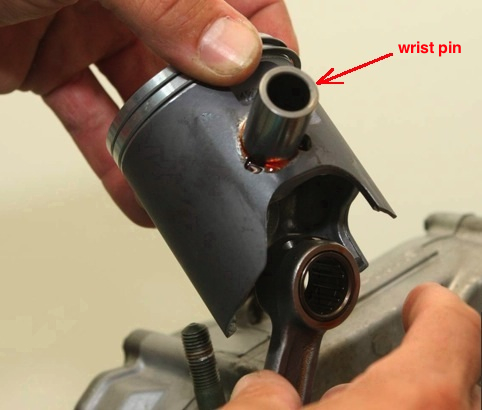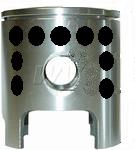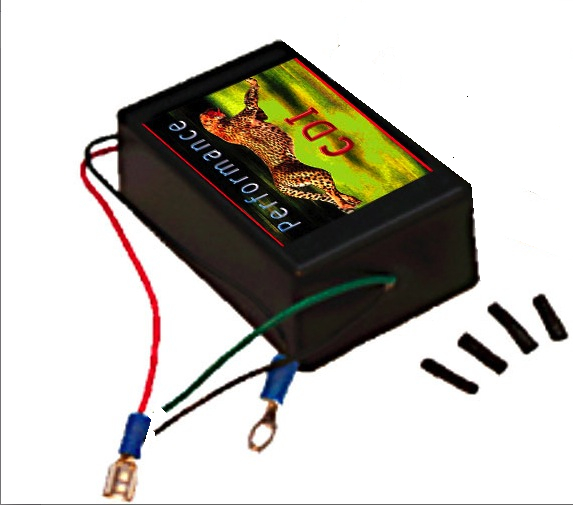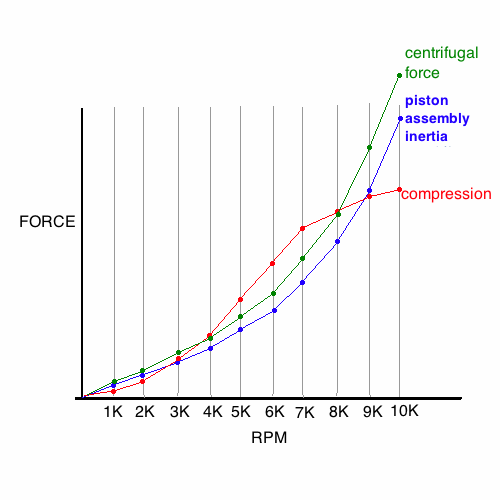The fix is two-fold. The first half of the fix affects vibration all through the rpm range. The second half of the fix lessens vibration only at the top rpm range where it is caused by the standard too-advanced ignition timing.

Generic 36mm x 10mm wrist pin & bearing $13
Generic 36mm x 10mm wrist pin $9
They probably also work in a 69cc engine since the piston is only 2mm wider. Also available is a 37.5mm long 10mm diameter titanium wrist pin (6.3mm I.D.) which is really good since titanium has around 58% the weight of stainless steel and is very strong. You can use a grinding wheel to shorten it if needed. It is 3 grams lighter than the 55cc/60cc wrist pins.
You can also lighten the piston by drilling holes in it that will be no more than 5mm from the side edges of the exhaust and intake port. Drill size is 9/32" and each hole shouldn't be closer than 10mm center-to-center from the next hole. Here's a photo showing where you can drill up to 9 holes on each side. Unfortunately, if the piston wall is 1.9mm thick (as mine is), only 18 holes will remove only 3.3 grams.


Here's a quote from Crankshaft Design, Materials, Loads and Manufacturing, by EPI Inc.
"Combustion forces and piston acceleration are the main source of external vibration produced by an engine. They must be counteracted by the implementation of the crankshaft counterweights." [A counterweight essentially exists opposite the rod pivot by the removal of metal near the connecting rod pivot on the flywheels]
The graph here shows what I want to explain about engine balancing. The increase in centrifugal force from the imbalanced flywheels and the up/down upper piston assembly inertia (as it changes direction) is exponential with rpm. But the combustion/dynamic-compression force varies with rpm mostly due to spark ignition timing.The flywheel counterbalance (created by holes near the conrod pin) has to keep the total balance not too far from true at peak combustion/compression and at peak rpm when the combustion/compression is sharply dropping off due to spark retard.

"Is the 2 cycle [69cc] motor known for a lot of vibration? I have some rubber pads between the mounts and the frame, but anything over about 15mph is just about unbearable." post
"My seat seems to be vibrating a little too much to comfortably ride long distances at full throttle. It seems to have gotten worse recently. Any idea how I could figure out where it is coming from? The engine mounts are solid I wrapped the frame in thick leather under the mounting hardware. I'm running the Chinese 66cc 2 stroke on a mountain bike." post
"I just finished my first motored bike build- a "Black Stallion" 66/80cc from Kings Motor Bikes. ...at the end of yesterdays ride I cranked it wide open to see what it could do. As it built RPMs, it passed a certain range and the entire bike began vibrating like the engine was totally mis-balanced! The gas tank loosened and shifted, and I had trouble keeping my hands on the handlebars! I dropped RPMs, and the vibration went completely away. I tried doing this several times, and each time I crossed that certain RPM barrier, the bike would go into wild vibration!" post
"I have a huffy panama jack bicycle, with a 80cc engine on it. I have such a bad vibration in the bike, its terrible.Ive tried rubber motor mounts, does anyone have any ideas? please help!!!!!!!!!!!!" post
Crankshaft balancing (for even less vibration):
An imbalance in the crankshaft in relation to the reciprocating weight of the upper end causes vibration and a loss of power. Making sure your engine is balanced correctly is essential, especially if you are modifying the engine to work in a different rpm range than what it was designed for. Using a lighter wrist pin lightens the balance area by 4.5 grams which is enough to balance the crankshaft in a stock 48cc. If it has higher compression and is ported for higher revs then the Jaguar CDI will be needed.
There is an old fashioned way of balancing the crank, with more weight removed from the counter-balance area for higher rpm. But in studying the subject I see that the main two forces that need to be counter balanced are changed in value of force equally as rpm increases so that rpm is not a factor. That means that the counter-balance mostly depends on the upper assembly weight and dynamic cylinder pressure, not on rpm. Cylinder pressure changes non-linearly with rpm, mostly due to ignition timing. On my bike with the ignition timing curve of the Jaguar CDI it has the most cylinder pressure at around 6750 rpm.
I have two different 55cc engines using different cylinders and pistons. One is with piston port intake and the other is reed valved. The results I got testing those, along with online calculators for upper piston assembly inertia force and the centrifugal force of the counter balance is what I base my theory of balancing on. The piston port engine was way off in balance, and the other was perfectly balanced. Using it as a base point I know I have to use 61% of the conrod weight as its contribution to the upper assembly weight. And I use the downward piston force instead of the upward force (which is more due to more piston speed going upward) or the average force. The increase in piston inertia force going upwards is offset by an unknowable amount of cylinder pressure which is why I don't use it.
1st test:Piston port intake 55cc engine (see engine details below) ported for 10,000 rpm but that achieved only 9100 since I just did the test runs with the standard exhaust pipe instead of an expansion chamber with the correct header length for 10,000 rpm. Anyway here are the details:
upper assembly weight: 122gm
additional counter balance weight removed: 9.8gm
The engine vibrated between 5600 and 7900 rpm and ran smooth before and after that rpm range.
55cc high rpm piston port intake engine:
55cc Grubee cylinder/head on 48cc bottom end
port durations: 185 exhaust, 119 transfers, 125 intake
transfer port walls removed for greater transfer area
stuffed crankcase
155 psi cranking pressure
18mm Mikuni
custom intake manifold
piston port intake
slant plug head with squish band .65mm from piston
Kawasaki KX65 piston and rings (adapted for use with piston port intake)
Jaguar CDI with Kawasaki KX high voltage coil
44 tooth rear sprocket
26" wheels with mountain bike tires
peak head temperature: 425F
2nd test:
My other 55cc engine (reed valve, Honda piston, torque pipe, 18mm Mikuni) with 77.3gm upper assembly with 15.8 grams removed via a 9.15mm diameter hole thru both flywheels allowed my engine to go up to 9150 rpm (downhill) without any bothersome vibration.
Here are the force evaluations of the two engines at 4000 rpm:
Upper assembly weight (piston, wrist pin, bearing, 61% of conrod):
piston port engine: 134.5 grams
reed valved engine: 120.5 grams
Downward assembly inertia force at 4000 rpm:
piston port engine: 78.45
reed valve engine: 68.7Centrifugal force of counterbalance*:
piston port engine: 60.2
reed valve engine: 68.7
Centrifugal force divided by Downward force:
piston port engine: .767
reed valve engine: 1.00
*In figuring the counter balance weight you have to include everything that would affect it. As example: my flywheel came with two 11.5mm diameter holes through both flywheels. The stainless steel there removed adds up to 50 grams. The conrod pin added 3.3 grams after the weight of the conrod pin holes weight were subtracted from it. The part of the conrod that is around the bearing, and the bearing itself, weigh around 30 grams. The centrifugal force has to be figured at the two distances of 19mm of the conrod, and 36mm of the counter balance holes.
Now we can calculate the needed "missing" balance weight for the 48cc Grubee engine. What I first noticed is that the existing balance holes are not the same distance from the center of the crankshaft as the connecting rod pin is. That is important because the farther a weight is from the centerpoint the more centrifugal force it has for the same rpm. Using a test weight of 1kg at this site I see that at the 36mm distance of the balance holes gives 1.9 times the centrifugal force as 1kg at the 19mm distance of the conrod pin.
Upper Assembly weight and downward inertia: 61% of the conrod is 43.5 grams and the piston assembly weighs 79 grams for a total of 122.5 grams. That weight at 4000 rpm (with 1.5" stroke and 3.35" conrod length) gives 71.45 pounds inertia force.
Counter balance weight and centrifugal force: The two factory-placed holes of 11.5mm diameter equate to 50 grams of missing weight which gives 71 pound-feet of centrifugal force at 4000 rpm (at 36mm radius). 30 grams of conrod bearing and "end" added to the 3.3 grams of the extra conrod pin weight gives 33.3 grams which gives 25 pound-feet of centrifugal force at 4000 rpm (at 19mm radius). 71 minus 25 equals 46 pound-feet.
Centrifugal Force to Downward Inertia Force Ratio: 46/71.45= .64 which is terrible.
Calculating needed counter balance weight removal: 71.45 - 46 = 25.45 pounds of force which requires 43.7 grams weight removal at the same 36mm distance as the existing holes. A 10mm diameter hole drilled through both flywheels will result in 41.5 grams removal according to this site (be sure tomultiply the resultant weight of kg by 1000 to get grams). But usually holes drilled are not perfect and so you can add about .15mm to the size. And so a 10.15mm hole will remove 42.8 grams which is close enough. A good quality drill bit of an equivalent 25/64" size is available for $16 online from Grainger. You can drill the hole yourself with an electric drill but it is hard and slow going. Best to do it at the machine shop.
piston inertia calculator steel weight calculator
Since upper assembly inertia and flywheel centrifugal force stay neck and neck thru the whole rpm range then it is just the changing compression/combustion force that varies with rpm. That is influenced by cranking compression and ignition timing. My balanced engine has 165 lbs cranking compression. High compression and advanced ignition are typical of enduro bikes, not racers. Race bikes have lower compression (typically 9:1) and retarded ignition. So my engine, being like an enduro bike, is just right with a 1/1force ratio. A race bike may need only .95/1 as a force ratio.
Here is a picture of my crank assembly with an additional balancing hole just above the conrod pin. The 6 blue holes are lightening holes for better acceleration (although I wouldn't recommend any more than 4 if the bike is for street use). The blue is foam filling half the hole. The ends of each hole were later filled with JBWeld. I used foam just to reduce the amount of expensive JBWeld used. The conrod hole and two factory balance holes are already filled with JBWeld for increased crankcase compression.

For the "80cc" engine, with a piston assembly of 107.6 grams and 11.15mm counterbalance holes at 36mm from shaft center I figure a 12.6mm extra hole is needed to balance the engine. (drill bit)
Concerning determining the weight of the lower conrod bearing and the part of the conrod that is around the bearing: I figured that by dipping the two into a measured amount of water and seeing how many cc (ml) they raise the water level. My 48cc had an equivalent 30 grams.

Buenos días; quiero comentarles que mi ciclomotor (48 cc) ha perdido fuerza en las subidas y no responde como antes; me pueden guiar qué debo hacer??? quiero repararla yo mismo por bajo presupuesto... jeje... :)
ReplyDeletebueno mira lo primero siempre es la limpieza, limpia bien el carburador y regulalo, luego apreta bien todas las tuercas y torillos que puedas, si podrias ser un poco mas especifico seria mas facil, por ejemplo, hace cuanto lo tenes, si lo usas mucho, el color de la bujia, si algunas vez lo arreglastes, etc, porque pueden ser muchas cosas, decime eso y yo te dire que es lo mas probable.
Deletesaludos
Hola amigo, gracias por responder. Llevo 6 meses con mi ciclomotor, lo uso todos los días como medio de transporte, la verdad ha sido una herramienta indispensable en mi día a día; desde hace unas semanas perdió fuerza en las subidas, le hice limpieza como usted me dijo, apreté todos los tornillos y mejoró nuevamente, Sin embargo, en ciertas ocasiones voy en una subida y pierde fuerza de un momento a otro, como si bajara su potencia, y a pocos segundos otra vez está bien, o en el arranque se demora en tomar velocidad como lo hacía antes. (será que están gastados los empaques y perdía presión el motor??? porque se apretó todo y mejoró). La verdad, lo que más me gustaba de mi ciclomotor era su fuerza, respondía de inmediato. El siguiente link es de un video que subí a youtube, en él enseño mi ciclomotor. Gracias por su atención. (Cristian Yara - Colombia).
Deletehttp://www.youtube.com/watch?v=_PxMK5RNdio&feature=youtube_gdata_player
antes que nada muchas gracias por visitar mi blog, mira depende de cuanto uso tenga el ciclomotor, si lo usastes mucho puede ser que se hallan gastado un poco las juntas de la culata del cilindro y la junta de la tapa, cosa que cuando ajustas mejora un poco, si te animas podes comprar las juntas y cambiarlas vos, es muy sencillo, se saca la tapa de cilindro, el cilindro, se cambia y se vuelve a armar.
Deletetambien puede que sea aros, pero no creo porque solo tiene 6 meses, debe estar perdiendo presion por alguna junta que no sella bien.
saludos
PD: si la junta de la culata del cilindro (osea la junta entre el cilindro y el block) sobresale proba mojarla un poco con agua, un poco nomas y fijate si hace burbujas o si sella y mejora.
Mi correo (por si a caso) para que me ayuden con mi ciclomotor es: mao272007@hotmail.com Gracias...!
ReplyDeletete respondo por aca mejor, asi si alguien que tiene un problema similar puede ver y entender.
Deletesaludos
No entendi la parte de cambiar el eje a travez del piston para uno mas liviano? que tengo que hacer? me gusto tu blog a ver como anda dsp de potenciarla, les voy a cerrar el orto a los que se rien de mi bicimoto jaja.Saludos
ReplyDeleteel tema es asi, como el cigueñal de estos motores no viene balanceado, hay que alivianar un poco la parte de biela piston para equipararlo un poco, por eso como el eje que trae de fabrica es medio malo, se le pone uno nuevo un poco mas liviano.
Deleteigualmente con las cosas que se puede hacer es el que menos efecto da lo unico que hara va a reducir un poco las vibraciones.
saludos
buenas, ya reduci tres mm del cabezote, le di seis pulgadas mas a la mufla como indicas, le deje el carburador ah once cm de distancia, le cambie el ruliman, le reduje cuatro mm de la falda del piston, y en realidad si funciona por que ahora corre mas rapido, pero la bobina me chispea, pues no se la eh cambiado, pero resulta que estos cambios se los estoy haciendo a un 60cc y me funciona, pero sientomucha vibracion, bueno no eh cambiado el eje de trasmision del piston.
ReplyDelete